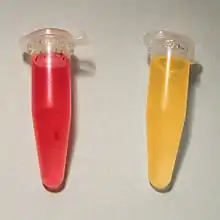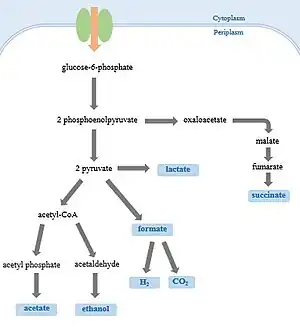In biochemistry, mixed acid fermentation is the metabolic process by which a six-carbon sugar (e.g. glucose, C6H12O6) is converted into a complex and variable mixture of acids. It is an anaerobic (non-oxygen-requiring) fermentation reaction that is common in bacteria. It is characteristic for members of the Enterobacteriaceae, a large family of Gram-negative bacteria that includes E. coli.[3]
The mixture of end products produced by mixed acid fermentation includes lactate, acetate, succinate, formate, ethanol and the gases H2 and CO2. The formation of these end products depends on the presence of certain key enzymes in the bacterium. The proportion in which they are formed varies between different bacterial species.[4] The mixed acid fermentation pathway differs from other fermentation pathways, which produce fewer end products in fixed amounts. The end products of mixed acid fermentation can have many useful applications in biotechnology and industry. For instance, ethanol is widely used as a biofuel.[5] Therefore, multiple bacterial strains have been metabolically engineered in the laboratory to increase the individual yields of certain end products.[2] This research has been carried out primarily in E. coli and is ongoing. Variations of mixed acid fermentation occur in a number of bacterial species, including bacterial pathogens such as Haemophilus influenzae where mostly acetate and succinate are produced and lactate can serve as a growth substrate.[6]
Mixed acid fermentation in E. coli
E. coli use fermentation pathways as a final option for energy metabolism, as they produce very little energy in comparison to respiration.[7] Mixed acid fermentation in E. coli occurs in two stages. These stages are outlined by the biological database for E. coli, EcoCyc.[1]
The first of these two stages is a glycolysis reaction. Under anaerobic conditions, a glycolysis reaction takes place where glucose is converted into pyruvate:
glucose → 2 pyruvate
There is a net production of 2 ATP and 2 NADH molecules per molecule of glucose converted. ATP is generated by substrate-level phosphorylation. NADH is formed from the reduction of NAD.
In the second stage, pyruvate produced by glycolysis is converted to one or more end products via the following reactions. In each case, both of the NADH molecules generated by glycolysis are reoxidized to NAD+. Each alternative pathway requires a different key enzyme in E. coli. After the variable amounts of different end products are formed by these pathways, they are secreted from the cell.[1]

Lactate formation
Pyruvate produced by glycolysis is converted to lactate. This reaction is catalysed by the enzyme lactate dehydrogenase (LDHA).[1]
pyruvate + NADH + H+ → lactate + NAD+
Acetate formation
Pyruvate is converted into acetyl-coenzyme A (acetyl-CoA) by the enzyme pyruvate dehydrogenase. This acetyl-CoA is then converted into acetate in E. coli, whilst producing ATP by substrate-level phosphorylation. Acetate formation requires two enzymes: phosphate acetyltransferase and acetate kinase.[1]

acetyl-CoA + phosphate → acetyl-phosphate + CoA
acetyl-phosphate + ADP → acetate + ATP
Ethanol formation
Ethanol is formed in E. coli by the reduction of acetyl coenzyme A using NADH. This two-step reaction requires the enzyme alcohol dehydrogenase (ADHE).[1]
acetyl-CoA + NADH + H+ → acetaldehyde + NAD+ + CoA
acetaldehyde + NADH + H+ → ethanol + NAD+
Formate formation
Formate is produced by the cleavage of pyruvate. This reaction is catalysed by the enzyme pyruvate-formate lyase (PFL), which plays an important role in regulating anaerobic fermentation in E. coli.[8]
pyruvate + CoA → acetyl-CoA + formate
Succinate formation

Succinate is formed in E. coli in several steps.
Phosphoenolpyruvate (PEP), a glycolysis pathway intermediate, is carboxylated by the enzyme PEP carboxylase to form oxaloacetate.[9] This is followed by the conversion of oxaloacetate to malate by the enzyme malate dehydrogenase. Fumarate hydratase then catalyses the dehydration of malate to produce fumarate.[10]
phosphoenolpyruvate + HCO3 → oxaloacetate + phosphate
oxaloacetate + NADH + H+ → malate + NAD+
malate → fumarate + H2O
The final reaction in the formation of succinate is the reduction of fumarate. It is catalysed by the enzyme fumarate reductase.
fumarate + NADH + H+ → succinate + NAD+
This reduction is an anaerobic respiration reaction in E. coli, as it uses electrons associated with NADH dehydrogenase and the electron transport chain. ATP is generated by using an electrochemical gradient and ATP synthase. This is the only case in the mixed acid fermentation pathway where ATP is not produced via substrate-level phosphorylation.[1][2]
Vitamin K2, also known as menaquinone, is very important for electron transport to fumarate in E. coli.[11]
Hydrogen and carbon dioxide formation
Formate can be converted to hydrogen gas and carbon dioxide in E. coli. This reaction requires the enzyme formate-hydrogen lyase. It can be used to prevent the conditions inside the cell becoming too acidic.[1]
formate → H2 and CO2
Methyl red test

The methyl red (MR) test can detect whether the mixed acid fermentation pathway occurs in microbes when given glucose. A pH indicator is used that turns the test solution red if the pH drops below 4.4.[12] If the fermentation pathway has taken place, the mixture of acids it has produced will make the solution very acidic and cause a red colour change.
The methyl red test belongs to a group known as the IMViC tests.
Metabolic engineering
Multiple bacterial strains have been metabolically engineered to increase the individual yields of end products formed by mixed acid fermentation. For instance, strains for the increased production of ethanol, lactate, succinate and acetate have been developed due to the usefulness of these products in biotechnology.[2] The major limiting factor for this engineering is the need to maintain a redox balance in the mixture of acids produced by the fermentation pathway.[13]
For ethanol production
Ethanol is the most commonly used biofuel and can be produced on large scale via fermentation. The maximum theoretical yield for the production of ethanol was achieved around 20 years.[14][15] A plasmid that carried the pyruvate decarboxylase and alcohol dehydrogenase genes from the bacteria Z. mobilis was used by scientists. This was inserted into E. coli and resulted in an increased yield of ethanol. The genome of this E. coli strain, KO11, has more recently been sequenced and mapped.[16]


For acetate production
The E. coli strain W3110 was genetically engineered to generate 2 moles of acetate for every 1 mole of glucose that undergoes fermentation. This is known as a homoacetate pathway.[17]
For lactate production
Lactate can be used to produce a bioplastic called polylactic acid (PLA). The properties of PLA depend on the ratio of the two optical isomers of lactate (D-lactate and L-lactate). D-lactate is produced by mixed acid fermentation in E. coli.[18] Early experiments engineered the E. coli strain RR1 to produce either one of the two optical isomers of lactate.[19]
Later experiments modified the E. coli strain KO11, originally developed to enhance ethanol production. Scientists were able to increase the yield of D-lactate from fermentation by performing several deletions.[20]
For succinate production
Increasing the yield of succinate from mixed acid fermentation was first done by overexpressing the enzyme PEP carboxylase.[21] This produced a succinate yield that was approximately 3 times greater than normal. Several experiments using a similar approach have followed.
Alternative approaches have altered the redox and ATP balance to optimize the succinate yield.[22]
Related fermentation pathways
There are a number of other fermentation pathways that occur in microbes.[4] All these pathways begin by converting pyruvate, but their end products and the key enzymes they require are different. These pathways include:
- Ethanol fermentation
- Lactic acid fermentation
- Propionic acid fermentation
- Butanol fermentation
- Butanediol fermentation
External links
References
- 1 2 3 4 5 6 7 8 Keseler, Ingrid M.; et al. (2011). "EcoCyc: a comprehensive database of Escherichia coli biology". Nucleic Acids Research. 39 (Database issue): D583–D590. doi:10.1093/nar/gkq1143. PMC 3013716. PMID 21097882.
- 1 2 3 4 Förster, Andreas H. & Johannes Gescher (2014). "Metabolic engineering of Escherichia coli for production of mixed-acid fermentation end products". Frontiers in Bioengineering and Biotechnology. 2: 506–508. doi:10.3389/fbioe.2014.00016. PMC 4126452. PMID 25152889.
- ↑ M.Magidan & J. Martinko (2006). "Brock's Biology of Microorganisms, NJ, Pearson Prentice Hall". 11: 352.
{{cite journal}}: Cite journal requires|journal=(help) - 1 2 Sharma, P.D. (2007). "Microbiology": 104.
{{cite journal}}: Cite journal requires|journal=(help) - ↑ Farrell, Alexander E.; et al. (2006). "Ethanol can contribute to energy and environmental goals". Science. 311 (5760): 506–508. Bibcode:2006Sci...311..506F. doi:10.1126/science.1121416. PMID 16439656. S2CID 16061891.
- ↑ Hosmer, Jennifer; Nasreen, Marufa; Dhouib, Rabeb; Essilfie, Ama-Tawiah; Schirra, Horst Joachim; Henningham, Anna; Fantino, Emmanuelle; Sly, Peter; McEwan, Alastair G.; Kappler, Ulrike (2022-01-27). "Access to highly specialized growth substrates and production of epithelial immunomodulatory metabolites determine survival of Haemophilus influenzae in human airway epithelial cells". PLOS Pathogens. 18 (1): e1010209. doi:10.1371/journal.ppat.1010209. ISSN 1553-7374. PMC 8794153. PMID 35085362.
- ↑ Sawers, R. Gary; Blokesch, Melanie; Böck, August (2004). "Anaerobic formate and hydrogen metabolism". EcoSal Plus. 1 (1). doi:10.1128/ecosalplus.3.5.4. PMID 26443350.
- ↑ Knappe, Joachim & Gary Sawers (1990). "A radical-chemical route to acetyl-CoA: the anaerobically induced pyruvate formate-lyase system of Escherichia coli". FEMS Microbiology Reviews. 6 (4): 383–398. doi:10.1111/j.1574-6968.1990.tb04108.x. PMID 2248795.
- ↑ Kai, Yasushi, Hiroyoshi Matsumura, and Katsura Izui (2003). "Phosphoenolpyruvate carboxylase: three-dimensional structure and molecular mechanisms". Archives of Biochemistry and Biophysics. 414 (2): 170–179. doi:10.1016/S0003-9861(03)00170-X. PMID 12781768.
{{cite journal}}: CS1 maint: multiple names: authors list (link) - ↑ Thakker, Chandresh; et al. (2012). "Succinate production in Escherichia coli". Biotechnology Journal. 7 (2): 213–224. doi:10.1002/biot.201100061. PMC 3517001. PMID 21932253.
- ↑ Guest, JOHN R (1977). "Menaquinone biosynthesis: mutants of Escherichia coli K-12 requiring 2-succinylbenzoate". Journal of Bacteriology. 130 (3): 1038–1046. doi:10.1128/jb.130.3.1038-1046.1977. PMC 235325. PMID 324971.
- ↑ H. T. Clarke; W. R. Kirner (1922). "Methyl Red". Org. Synth. 2: 47. doi:10.15227/orgsyn.002.0047.
- ↑ van Hoek; Milan JA & Roeland MH Merks (2012). "Redox balance is key to explaining full vs. partial switching to low-yield metabolism". BMC Systems Biology. 6 (1): 22. doi:10.1186/1752-0509-6-22. PMC 3384451. PMID 22443685.
- ↑ Ingram, L. O.; et al. (1987). "Genetic engineering of ethanol production in Escherichia coli". Applied and Environmental Microbiology. 53 (10): 2420–2425. Bibcode:1987ApEnM..53.2420I. doi:10.1128/aem.53.10.2420-2425.1987. PMC 204123. PMID 3322191.
- ↑ Ohta, Kazuyoshi; et al. (1991). "Genetic improvement of Escherichia coli for ethanol production: chromosomal integration of Zymomonas mobilis genes encoding pyruvate decarboxylase and alcohol dehydrogenase II". Applied and Environmental Microbiology. 57 (4): 893–900. Bibcode:1991ApEnM..57..893O. doi:10.1128/aem.57.4.893-900.1991. PMC 182819. PMID 2059047.
- ↑ Turner, Peter C.; et al. (2012). "Optical mapping and sequencing of the Escherichia coli KO11 genome reveal extensive chromosomal rearrangements, and multiple tandem copies of the Zymomonas mobilis pdc and adhB genes". Journal of Industrial Microbiology & Biotechnology. 39 (4): 629–639. doi:10.1007/s10295-011-1052-2. PMID 22075923. S2CID 15100287.
- ↑ Causey, T. B.; et al. (2003). "Engineering the metabolism of Escherichia coli W3110 for the conversion of sugar to redox-neutral and oxidized products: homoacetate production". Proceedings of the National Academy of Sciences. 100 (3): 825–832. Bibcode:2003PNAS..100..825C. doi:10.1073/pnas.0337684100. PMC 298686. PMID 12556564.
- ↑ Clark, David P (1989). "The fermentation pathways of Escherichia coli". FEMS Microbiology Reviews. 5 (3): 223–234. doi:10.1111/j.1574-6968.1989.tb03398.x. PMID 2698228.
- ↑ Chang, Dong-Eun; et al. (1999). "Homofermentative production of d-orl-lactate in metabolically engineered Escherichia coli RR1". Applied and Environmental Microbiology. 65 (4): 1384–1389. Bibcode:1999ApEnM..65.1384C. doi:10.1128/AEM.65.4.1384-1389.1999. PMC 91196. PMID 10103226.
- ↑ Zhou, S.; et al. (2005). "Fermentation of 10%(w/v) sugar to D (−)-lactate by engineered Escherichia coli B". Biotechnology Letters. 27 (23–24): 1891–1896. doi:10.1007/s10529-005-3899-7. PMID 16328986. S2CID 43204090.
- ↑ Millard, Cynthia Sanville; et al. (1996). "Enhanced production of succinic acid by overexpression of phosphoenolpyruvate carboxylase in Escherichia coli". Applied and Environmental Microbiology. 62 (5): 1808–1810. Bibcode:1996ApEnM..62.1808M. doi:10.1128/aem.62.5.1808-1810.1996. PMC 167956. PMID 8633880.
- ↑ Singh, Amarjeet; et al. (2011). "Manipulating redox and ATP balancing for improved production of succinate in E. coli". Metabolic Engineering. 13 (1): 76–81. doi:10.1016/j.ymben.2010.10.006. PMID 21040799.
